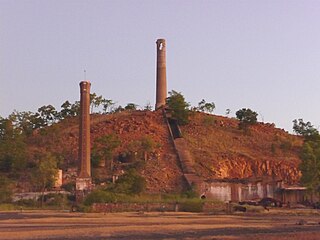
A blast furnace is a type of metallurgical furnace used for smelting to produce industrial metals, generally pig iron, but also others such as lead or copper. Blast refers to the combustion air being "forced" or supplied above atmospheric pressure.
In the mining industry or extractive metallurgy, beneficiation is any process that improves (benefits) the economic value of the ore by removing the gangue minerals, which results in a higher grade product (concentrate) and a waste stream (tailings). There are many different types of beneficiation, with each step furthering the concentration of the original ore.

Captains Flat is a town in the Southern Tablelands of rural New South Wales, Australia, in Queanbeyan-Palerang Regional Council. It is south of Queanbeyan. Captains Flat township is bounded by the non-urban parts of the locality of Captains Flat in the north, east and west, and Captains Flat Road, the Molonglo River and Foxlow Street in the south.
Coombing Park is a farming property situated in western New South Wales just off the Mid-Western Highway about 5 km west of Carcoar, 260 km west of Sydney and 54 km south-west of Bathurst. The property is of considerable note because of its relationship with convicts, bushrangers and the Cobb & Co coaching company. The property was offered as an estate to its owner Thomas Icely by the early New South Wales Government in 1826. It was one of the first estates created on the western side of the Blue Mountains that border the area of Sydney.

Bookham is a small village in the Southern Tablelands and Riverina regions of New South Wales, Australia in Yass Valley Shire. It is about 29 km west of Yass on the Hume Highway.

Onota was a village in the Upper Peninsula of the U.S. state of Michigan. It was located on the Grand Island Bay of Lake Superior near the present-day community of Christmas about five miles (8 km) west of Munising in Alger County. The site of Onota is within the Bay Furnace Campground and Picnic Area of the Hiawatha National Forest. The remains of Bay Furnace, a blast furnace used for smelting iron, is the only extant remnant of the town. Bay Furnace was listed on the National Register of Historic Places and designated a Michigan State Historic Site in 1971.

Tallawang is an historical locality north of Gulgong in central western New South Wales, Australia. The place name is derived from an aboriginal word for "apple gum".

Leadville is a town in New South Wales, Australia. The town is located in the Warrumbungle Shire local government area, 376 kilometres (234 mi) north west of the state capital, Sydney. At the 2006 census, Leadville and the surrounding area had a population of 186.

The Chillagoe smelters is a heritage-listed refinery at Chillagoe-Mungana Caves National Park, Mareeba Mining District, Chillagoe, Shire of Mareeba, Queensland, Australia. It operated in the early 1900s. It is also known as Chillagoe State Smelters. It was added to the Queensland Heritage Register on 21 October 1992.

The Fitzroy Iron Works at Mittagong, New South Wales, was the first commercial iron smelting works in Australia. It first operated in 1848.

Mount Clara smelter is a heritage-listed former copper smelter at Rossmore Road, in the upper reaches of Fat Hen Creek, Oakview, Gympie Region, Queensland, Australia. It was built in 1873. It was added to the Queensland Heritage Register on 21 October 1992.

Plants for the production of lead are generally referred to as lead smelters. Primary lead production begins with sintering. Concentrated lead ore is fed into a sintering machine with iron, silica, limestone fluxes, coke, soda ash, pyrite, zinc, caustics or pollution control particulates. Smelting uses suitable reducing substances that will combine with those oxidizing elements to free the metal. Reduction is the final, high-temperature step in smelting. It is here that the oxide becomes the elemental metal. A reducing environment pulls the final oxygen atoms from the raw metal.

The Lithgow Blast Furnace is a heritage-listed former blast furnace and now park and visitor attraction at Inch Street, Lithgow, City of Lithgow, New South Wales, Australia. It was built from 1906 to 1907 by William Sandford Limited. It is also known as Eskbank Ironworks Blast Furnace site; Industrial Archaeological Site. The property is owned by Lithgow City Council. It was added to the New South Wales State Heritage Register on 2 April 1999.
Lal Lal Iron Mine and Smelting Works were located close to the western branch of the Moorabool River, near the town of Lal Lal, Victoria, Australia, which lies on the Geelong-Ballarat railway line about 19 km from Ballarat. From 1875 to 1884, pig iron was made there in a blast furnace using iron ore mined at the site, locally produced charcoal, and limestone from a nearby deposit. The works ultimately proved to be uneconomic. It remains the only attempt to establish an iron smelting industry in Victoria.
Enoch Hughes was an English-born iron-master and pioneer of the iron industry in both Australia and New Zealand.

The British and Tasmanian Charcoal Iron Company (BTCIC) was an iron mining and smelting company that operated from 1874 to 1878 in Northern Tasmania, Australia. It was formed by floating the operations of a private company, the Tasmanian Charcoal Iron Company that operated between 1871 and 1874.
The Tamar Hematite Iron Company (THIC) was an iron mining and smelting company that operated from April 1874 to December 1877, in the area close to the location of the modern-day township of Beaconsfield,Tasmania, Australia.

The Ilfracombe Iron Company (I.I.C.) was an iron mining and smelting company that operated in Northern Tasmania in 1873 and 1874.

The Wundowie charcoal iron and wood distillation plant manufactured pig iron between 1948 and 1981 and wood distillation products between 1950 and 1977, at Wundowie, Western Australia.

Charles Henry Hoskins (1851-1926) was an Australian industrialist, who was significant in the development of the iron and steel industry in Australia.

















